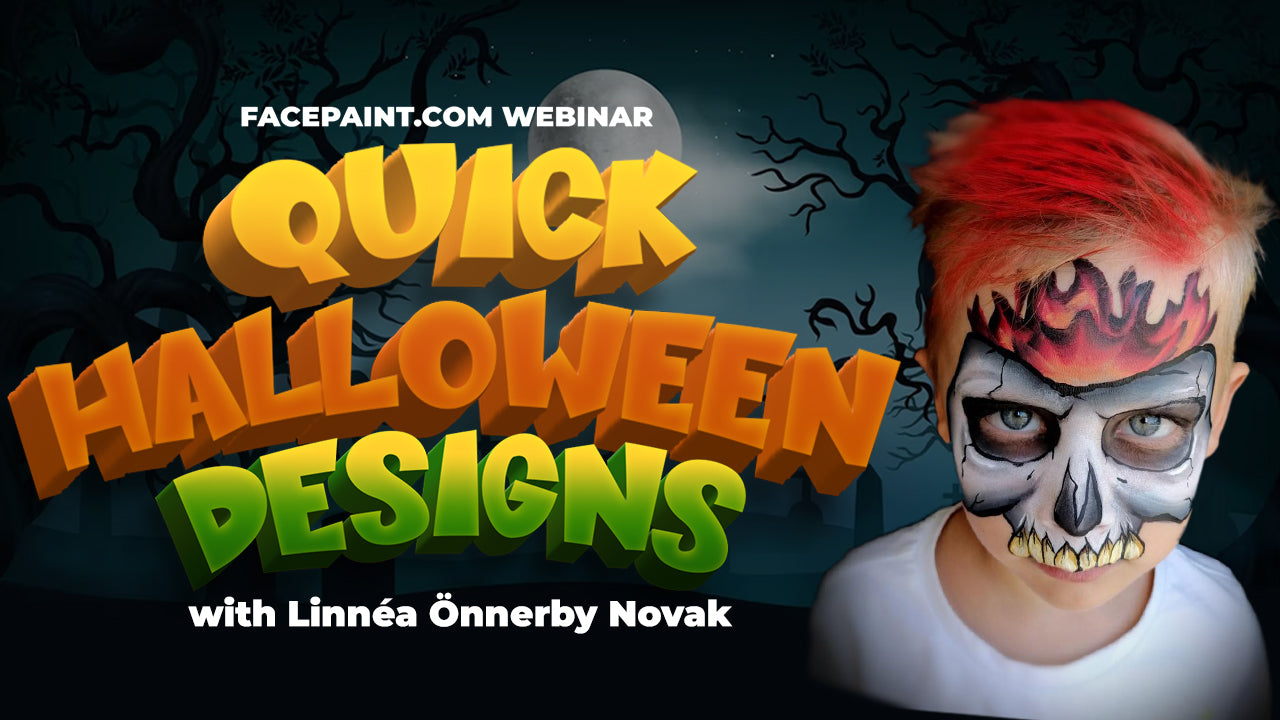Most face painters carry a selection of glitter tattoo stencils with them to events. The advantage of glitter tattoos is that they are waterproof, and once applied, can last several days if they are taken care of. They are also a nice change of pace during a party, and one great advantage is that even for those days when you feel you’re off your game a bit when it comes to art, the stencil creates your outline, so with a little practice, you can achieve a consistent results with each use.
If you’ve tried creating freehand stencils, however, you may have found these more challenging when it comes to consistent quality. The glue does not flow as easily as face paint. Freehand tattoos require that you also carry 91% or 99% alcohol to clean your brushes, which means extra equipment to tote. Finally, the adhesive dries clear, making it extremely difficult to tell where you’ve been and where you still need to paint on your subject.
To get around this last problem, some face painters suggest mixing in a little face paint with your adhesive so you can see a faint tinge of color on the skin. Some manufacturers of glitter adhesive even provide a tinted brand to help you see it better once it has dried. This is helpful, but you still won’t be able to see the outline well.
While I was thinking it over this morning, I realized there is another solution to the invisible adhesive problem: tinting the adhesive with UV reactant face paint and using a blacklight. By using this technique, I hope this tutorial will help you create freehand glitter tattoos more easily in the future.
Materials:
• UV reactant face paint
• Small vial for mixing glitter adhesive and face paint
• Blacklight lighting source, such as a small lamp or flashlight
• Small round brush
• 91% or 99% rubbing alcohol
• Opaque cosmetic glitter
• Glitter tattoo adhesive
Freehand Glitter Tattoos Tutorial
Step 1
Begin by preparing your adhesive ahead of time. I decanted mine into a small container with a lid to make it easy to use with a brush, which is what Leah Reddell suggests if you’re going to do freehand glitter tattoos.
Using a toothpick, stir in a few drops of UV reactant face paint which you’ve mixed up to a thick, liquid consistency so that you can drip it in. I used Diamond FX blue and white. If you use the blue, you’ll have a slightly better chance of seeing what you’re doing under regular light, too, or you can also add some regular face paint, which may have more opacity.
Step 2:
Switch on your black light. I picked up this blacklight bulb at the local hardware store (it cost around $8) and put it in a regular lamp, but you can buy an actual blacklight lamp. I also invested in a few small blacklight flashlights, which are nicely portable and very bright.
You can see how my glitter adhesive glows well with only a few drops of the UV reactive paint in it. I tried it out on my hand to see how it would appear under the light.
Step 3:
Rinse your brush in the alcohol solution. Remember that 75% is fine for cleaning and prepping the skin before you apply your glitter tattoo, but you really need the highest alcohol content you can get for cleaning your brush. The alcohol and adhesive are going to be hard on your brushes, so it’s best to keep your glitter tattoo brushes entirely for that purpose. (I also label my glass jar of alcohol so that no one mistakes it for water. It has an odor, but it’s better to be safe than sorry.)
Step 4:
Begin painting your design while the blacklight is on. For this one, I chose an easy dragon design to which I’ll apply black glitter to when it’s dry. My camera doesn’t do it justice, but you can see how well it glows under the blacklight.
Here’s an example of what it looks like without the blacklight. Because I added some blue, you can still see a faint design, but if you don’t have good lighting, it’s definitely more difficult to see than it is with the blacklight version.
Step 5:
If you use the blacklight to add glitter, it will be easier to see where you need to put the glitter. I added the glitter under a normal light, though, since once I had the glitter down, I could see my design fairly well. You’ll find which way works best for you as you experiment.
Step 6:
After your glitter is in place, press it with your finger so that the maximum amount stays on the adhesive and sweep the rest away. You’ll probably notice a few areas that need to be touched up. If so, turn your blacklight back on and add a little more adhesive to any edges which need it.
When you’re finished, you’ll have a nice freehanded glitter tattoo design over which you had pretty good control while doing the brushwork.
As you’re working with glitter adhesive for freehand tattoos, keep in mind that at some point, your customer is going to want to remove it. Most likely, he or she will only have 75% alcohol to work with, making it harder to break up the adhesive, so don’t layer the glue to make it thicker. (There will be a temptation to do this so you get a better glow under your blacklight.) The more adhesive you put on, the harder it will be to remove. Keep the coating thin and your customer will thank you later. I only used a few small drops, and it made the paint show up well under a blacklight, but it would be better to add a little more UV paint to your adhesive to make it glow more intensely than for the customer to have trouble removing it later.
Beth MacKinney is the owner of and primary face painter for Face Paint Pizzazz in the NW Chicago suburbs.













